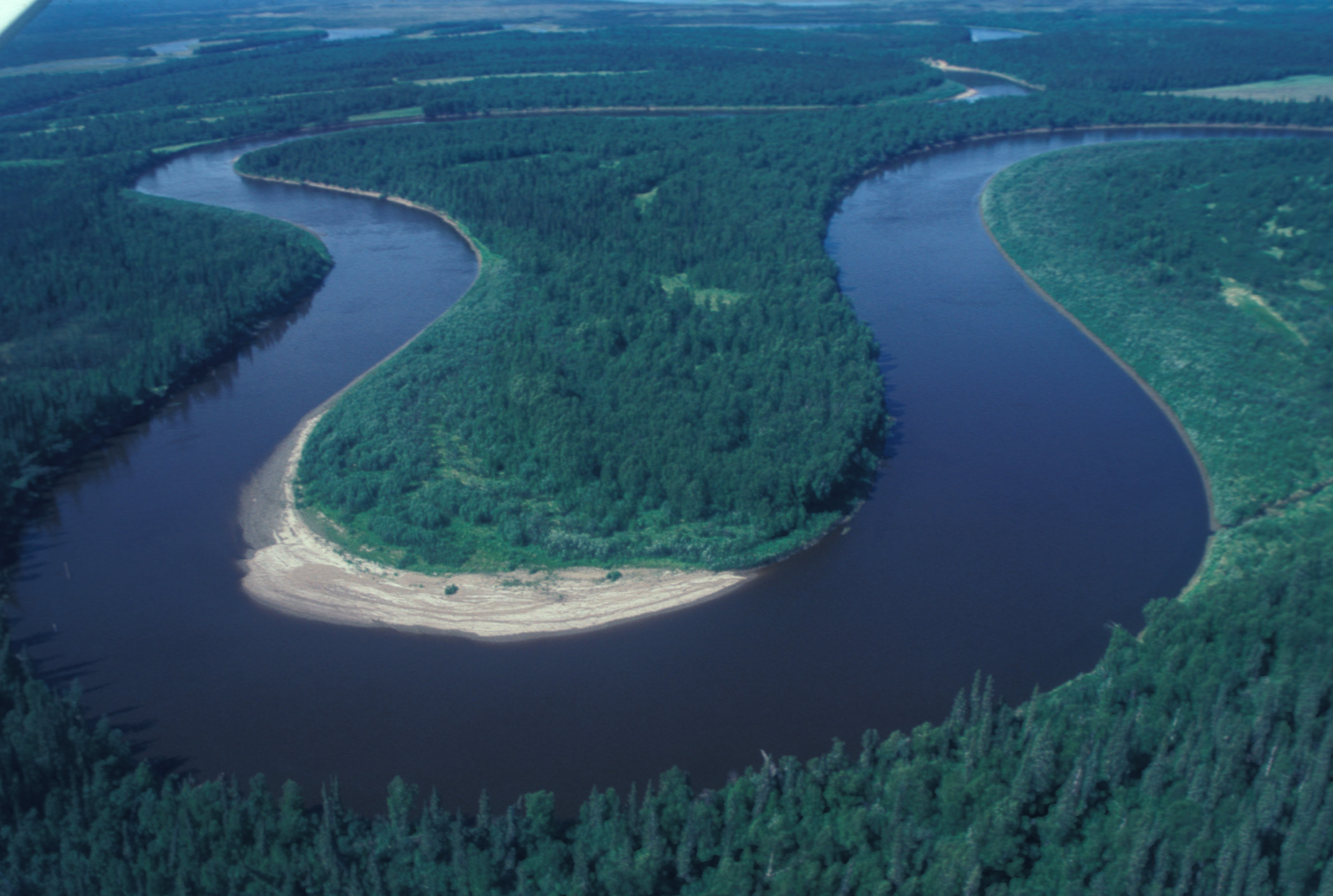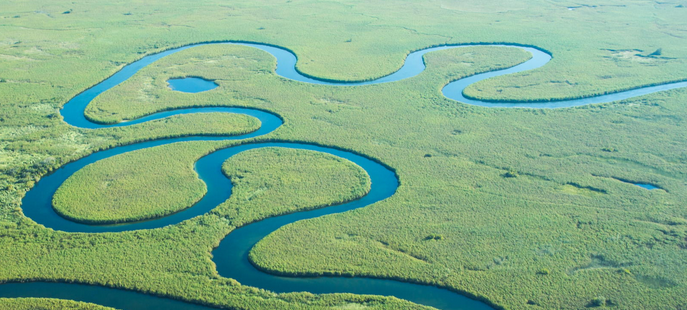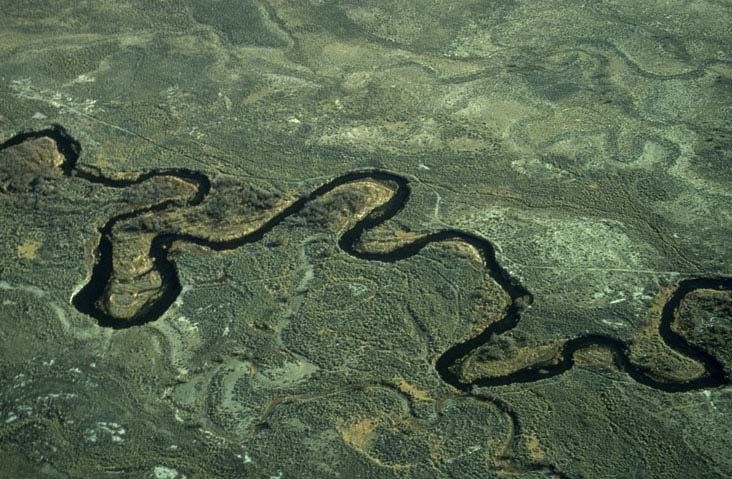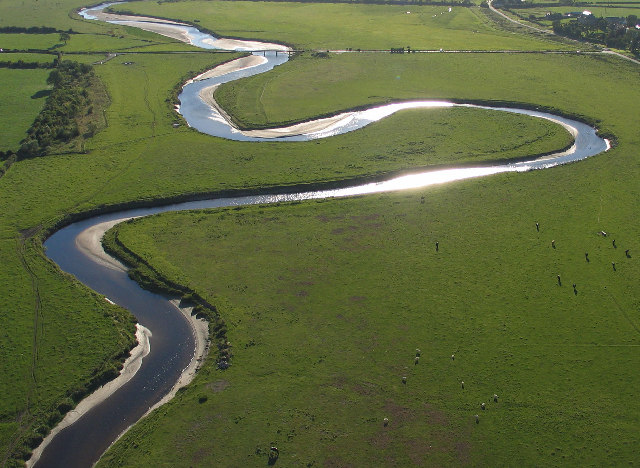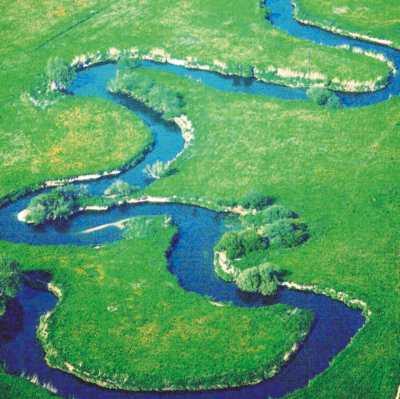Meander
Meander is the name of a river loop in a sequence of such, as in sections with low bed slope and bed load transported simultaneously it forms (sand, gravel, stones). An isolated flow loop in the river, however, is not called a meander. As a simple measure of the intensity of the meandering, the sinuosity is used.
Etymology
The word meander comes from the Greek name Μαίανδρος ( Maeander ) for the rivers Menderes ( Meander Big and Small Meander ) in western Turkey. The word is not derived from translations for " loop ", " loop ". Even in ancient times called the watercourses were known for their numerous meanders.
Cause
Mäandrierungsanalyse the example of the Lower Elbe
Cause of meandering is caused by the soil friction of the water cross- circulation, which leads along the river bottom from the outside of the curve side to side inside of the curve and leads to the river surface back to the outside of the bend page. In this way material of the soil flow is carried from the outside and the curves continues. This cross- circulation occurs as follows:
Effect
Contact between two adjacent loops, the water takes the resulting shortcut and it remains a backwater, which silted up over time. Surrounded by backwaters increased area called Umlaufberg.
However, can form larger or smaller rapids at these break-in points of the river depending on the size of the difference in height between the beginning and end of the former river bend because of the gradient. These lead to a regressive erosion. The river erodes with time backwards, thus also above the Altwassers, deeper. The backwater is then largely a dry valley, such as the Umlaufberg Etzhardt at Mayschoß with arroyo near Altenburg in the Ahr valley.
Because of the stronger flow gradient on younger Mäanderdurchbrüchen are often mills there.
In rivers where run political boundaries, usually its thalweg is used in border treaties as a border line so that the membership of islands can be clearly regulated. If a (former ) river course once defined geodetic, changes in the river course in the formation of surfaces may cause which, although still part of a territorial unit, but separated from it by the new course of the river and thus often do not (or only over foreign territory ) are accessible. Occasionally it happens in these cases, the land swap; further to provide such areas also as a nature reserve or retention area.
Species
Talmäander
Follow the course of the valley and shape it further as described above. The resulting circulation mountains here are therefore usually relatively high.
For subsequent terrain elevation a river can cut deep under their accrued in the lowlands loop forming the mountains. However, such Zwangsmäander must have been initiated not necessarily by a " historically given " meandering. They can arise due to geologically predetermined formations, such as the Middle Rhine or the Moselle arches.
Auenmäander
Flow in a spacious valley, mostly in river Endläufen without it to shape itself. The loops of the river meander in the valley itself back and forth.
Nature and Man
Strongly meandering rivers, like the Mississippi and the Rhine have frequently been made navigable by river regulation. The Rhine was shortened only by the initiated by Johann Gottfried Tulla between 1817-1819 straightening of Karlsruhe to Mannheim from 135 km to 86 km. Such a flow straightening causes a lowering of the groundwater level and the increased flow rate greater erosion of the riverbed result, so there is a higher risk of flooding for subsequent sections of the river. The agricultural usability of the contacting surfaces and the water supply fitting forest land is changed.
The physical forces of the Mississippi, which led over time to be superimposed Mäanderverläufen, are part of the American folk mythology. In the 1940s, a large study by geologist Harold Fisk was performed. Fisk examined with a team of geologists and geographers the rivers of the Mississippi - his main and secondary currents, the dead side arms and the dried-up river beds and the alluvial. Fisk's study is available online.
Meanwhile flows be covered in part back to the old meanders. Preference is given to those who do not serve the shipping industry and have just been straightened because of the rapid runoff of water. Such sections of the river are the Nidda in the area of Bad Vilbel Frankfurt in, the Main between Bamberg and light rock in the area Unterbrunn. In the course of restoration measures, smaller streams are meandering again. Meanders are also found south of the Saxon town of hurry castle in the valley of the trough, which forms many such natural phenomena largely there as its tributaries.

